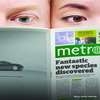Metro News
Metro News wanted to increase readership of its free dailies, published in five Canadian cities, without printing more papers. They needed to be deemed worthy of being left behind or passed along.
“News worth sharing” became the rallying cry, with the call to action of “Pass it on.” Space was leveraged on Metro boxes and in Metro papers to reach known readers directly, with paper wraps, in-paper ads and box cards.
Transit ads targeted commuters. In one, two gentlemen sit across from each other on a subway car, one is reading the front of the Metro while the other reads the back. In another, the reader is hidden behind the paper, but one hand holding it belongs to a man and the other, to a woman.
Billboards, digital screens and bus kings also targeted commuters, and 30-second radio spots aired in Metro’s five markets. Online, animated banners similar to the print ads were displayed nationally. In one TV spot, a woman reading her Metro on a bus is surprised by the hairy male arm that reaches over to turn her page.
A “Sharing Board” was set-up in Vancouver, with slots encouraging people to leave and take Metros. In Toronto, a copy of the paper was set up in a revolving door so that each person would have the view of one page.
And to help Metro promote its mobile app, tiny Metro mini-boxes were secured to poles around the city and prompted people to open them for their pocket-sized copy. A QR code then led them to the app download page.
While the campaign goal was to raise per-copy readership by 13%, without printing a single extra copy of Metro, daily readers per copy increased by 25%.

 Finalist
Finalist




